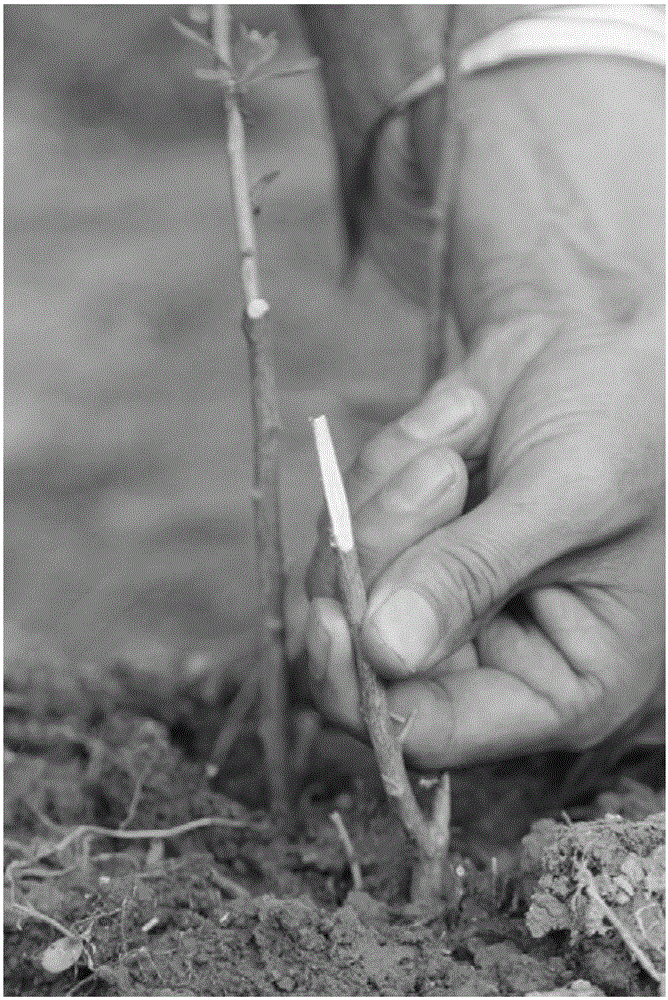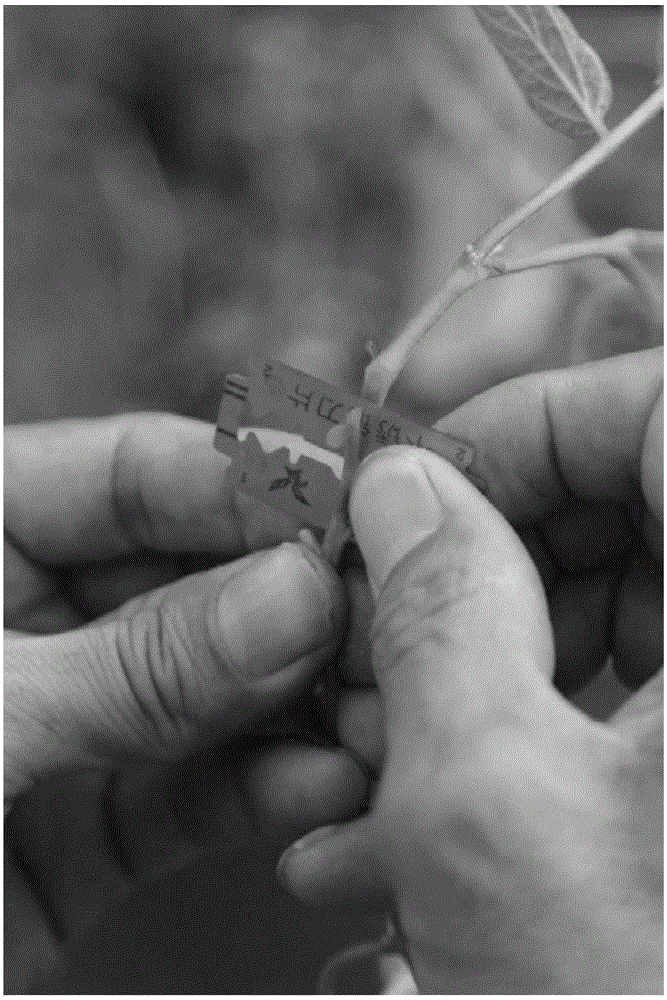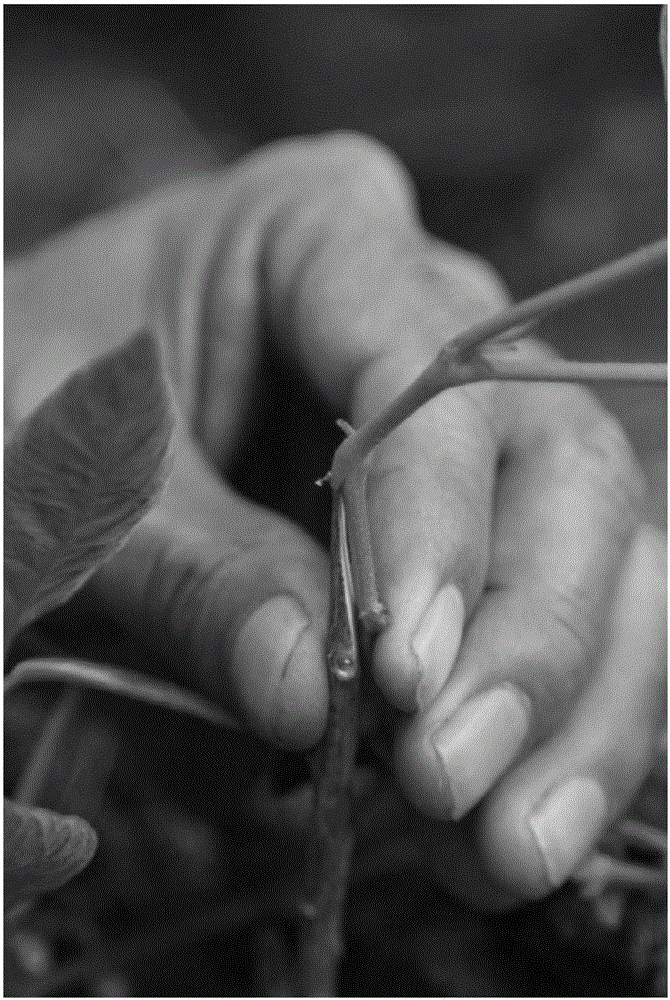Matrimony vine tomato grafting method
A technology of tomato and wolfberry, applied in the fields of botanical equipment and methods, horticulture, application, etc., can solve the problems of poor cold resistance of tomato plants, unable to survive winter safely, etc., and achieve the effects of improving health care function, increasing fruiting rate, and enhancing cold resistance.
- Summary
- Abstract
- Description
- Claims
- Application Information
AI Technical Summary
Problems solved by technology
Method used
Image
Examples
Embodiment 1
[0044] In this embodiment, a method of grafting tomatoes with wolfberry is adopted, and the method includes the following steps:
[0045] The grafting time is close to the evening on a sunny afternoon in April, and the ambient temperature is 15-20℃;
[0046] (1) Choose the live wolfberry seedlings with xylem as the rootstock for grafting, and plant the live wolfberry seedlings in a nutrient bowl before grafting;
[0047] (2) Tomato branches used as grafting scions are only scratched and not cut;
[0048] (3) The live wolfberry seedlings are sown 3 days earlier than the tomato branches used as scions, and the tomato branches are grafted on the live wolfberry seedlings under shading conditions;
[0049] The specific steps of grafting are as follows:
[0050] a. Such as figure 1 As shown, choose the live wolfberry seedlings with a thickness of 0.3-0.6cm with xylem and use a grafting knife to obliquely cut a knife edge of 1-1.5cm long, peel off the skin layer on the back of the top of the kn...
Embodiment 2
[0059] A method for grafting tomatoes with wolfberry, the method includes the following steps:
[0060] The grafting time is close to evening on a cloudy afternoon in April, and the ambient temperature is 15-20℃;
[0061] (1) Choose the live wolfberry seedlings with xylem as the rootstock for grafting, and plant the live wolfberry seedlings in a nutrient bowl before grafting;
[0062] (2) Tomato branches used as grafting scions are only scratched and not cut;
[0063] (3) The live wolfberry seedlings are sown 3 days earlier than the tomato branches used as scions, and the tomato branches are grafted on the live wolfberry seedlings;
[0064] The specific steps of grafting are as follows:
[0065] a. Choose the live wolfberry seedlings with a thickness of 0.3-0.6cm with xylem, and use a grafting knife to obliquely cut a 1-1.5cm-long knife edge, peel off the skin on the reverse side of the knife edge, and set aside;
[0066] b. Cut off the 1-1.5cm long cortex on the 0.2-0.5cm thick tomato br...
Embodiment 3
[0074] A method for grafting tomatoes with wolfberry, the method includes the following steps:
[0075] The grafting time is a sunny morning in September, and the ambient temperature is 20-25℃;
[0076] (1) Choose the live wolfberry seedlings with xylem as the rootstock for grafting, and plant the live wolfberry seedlings in a nutrient bowl before grafting;
[0077] (2) Tomato branches used as grafting scions are only scratched and not cut;
[0078] (3) The live wolfberry seedlings are sown 4 days earlier than the tomato branches used as scions, and the tomato branches are grafted on the live wolfberry seedlings under shading conditions;
[0079] The specific steps of grafting are as follows:
[0080] a. Choose the live wolfberry seedlings with a thickness of 0.3-0.6cm and have a xylem. Use a grafting knife to obliquely cut a 1-1.5cm-long knife edge, peel off the skin on the reverse side of the knife edge, and set aside;
[0081] b. Cut off the 1-1.5cm long cortex on the 0.2-0.5cm thick t...
PUM
| Property | Measurement | Unit |
|---|---|---|
| Roughness | aaaaa | aaaaa |
Abstract
Description
Claims
Application Information
 Login to View More
Login to View More - R&D
- Intellectual Property
- Life Sciences
- Materials
- Tech Scout
- Unparalleled Data Quality
- Higher Quality Content
- 60% Fewer Hallucinations
Browse by: Latest US Patents, China's latest patents, Technical Efficacy Thesaurus, Application Domain, Technology Topic, Popular Technical Reports.
© 2025 PatSnap. All rights reserved.Legal|Privacy policy|Modern Slavery Act Transparency Statement|Sitemap|About US| Contact US: help@patsnap.com



